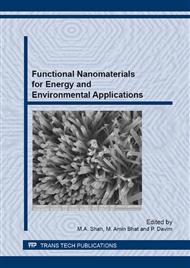p.1
p.9
p.15
p.23
p.33
p.39
p.43
p.53
Comparative Analysis of Antibiotic Effect of AgNO3 and Silver Nanoparticles Synthesized from Penicillium fellutanum
Abstract:
The proposed study was to synthesize silver nanoparticles by using filamentous fungus Penicillium fellutanum. From the ancient period, silver has been used against microorganisms due to its own antibacterial properties. The fungal culture of Penicillium fellutanum was isolated from the soil samples of Sathyabama University, Chennai, Tamil Nadu, India. The fungal isolates were inoculated in culture medium and incubated at room temperature for three days and the culture filtrate was separated and divided into two parts. One part of the culture filtrate was mixed with equal volume of 1mM silver nitrate [AgNO3,(1 mM)] and agitated at room temperature in dark condition. And the second half was kept as such. In the other hand only 1mM silver nitrate was added into the equal volume of Milli Q water and one half was plain Milli Q water. All the four samples were tested against pathogens like Bacillus cereus, E. coli, Proteus vulgaris, Staphylococcus aureus, Staphylococcus epidermidis and the results were compared. Proteus vulgaris showed the highest zone where E coli showed the least zone of inhibition, in the culture filtrate added with silver nitrate. The cell filtrate on treatment with silver nitrate and prior incubation were observed for change in color and characterized by UV-Vis spectrophotometer which detected AgNPs in the solution. The maximum absorbance 410nm confirmed the formation of silver nanoparticles. Size and morphology of silver nanoparticle were investigated using Atomic Force microscopy (AFM). The silver Nanoparticles after confirmation were checked for its antibacterial activity against selected pathogenic bacteria. The biologically synthesized Nanoparticles from Penicillium fellutanum showed the good inhibitory effect against the selected pathogens, which would be the novel remedy substituent in the place of high dose antibiotics.
Info:
Periodical:
Pages:
9-14
Citation:
Online since:
July 2013
Authors:
Keywords:
Price:
Сopyright:
© 2013 Trans Tech Publications Ltd. All Rights Reserved
Share:
Citation:


